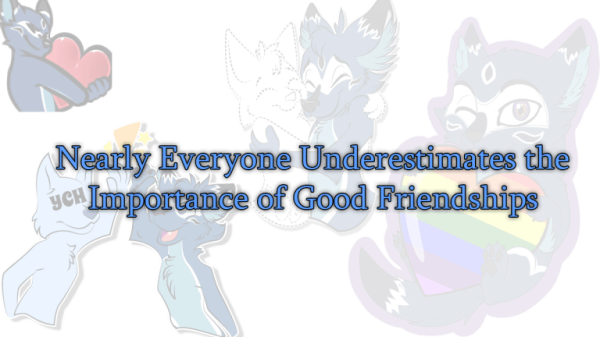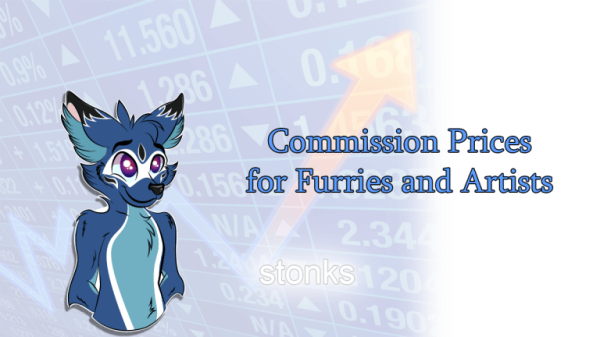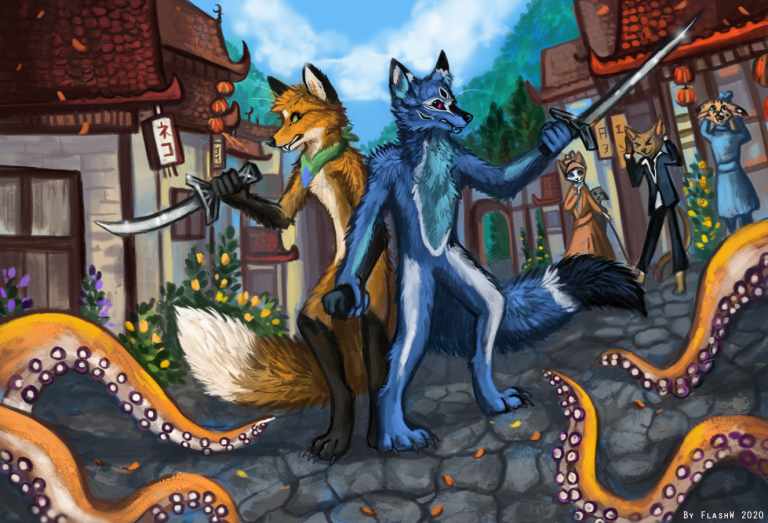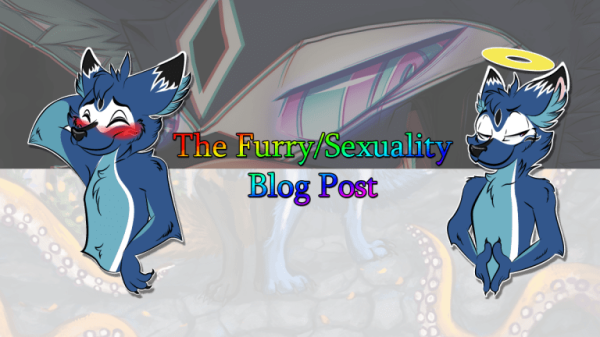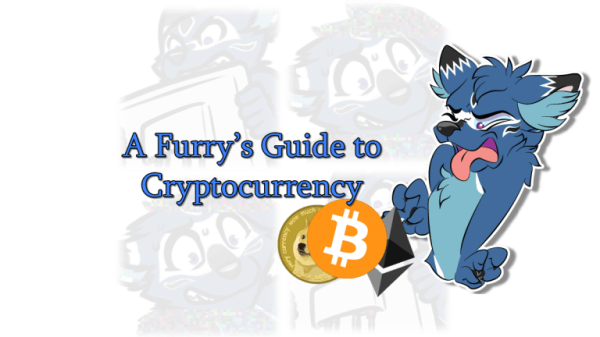Search
Items tagged with: furryArtists
A frequent source of confusion in the furry fandom is about commission pricing for furry art.
This confusion is often driven by (usually younger) furries demanding free or severely cheap art from artists, and the aftermath of such exchanges. There’s a reason @SpicyFurryTakes posts so frequently.
In the interest of not adding to the confusion, I’d like to offer a simple algorithm for artists to use for their standard commission prices, and then some guidelines for artists and commissioners to make the art commissioning experience better for everyone.
As my goal here is to simplify, I will be taking liberties and eschewing a lot of the economic details. If you feel that I made a mistake but aren’t sure because I’m not showing my work, feel free to leave a comment.

Commission Pricing For Artists
If you’re an artist reading this, you should almost certainly raise your rates.
Furry artists in particular are notorious for undercharging for all their time and hard work. We’re talking single-digit percentages of what industry professionals charge for roughly equivalent quality.
And then when one encounters a financial emergency, they desperately scramble to take on a lot more work just to pay for whatever life event happened. If the artist hadn’t been leaving so much money on the table with their commissioners, they probably wouldn’t need to do emergency commissions in the first place–let alone endure the mental toll of delivering on them.
It’s tragic.
If you’re not sure how much you should charge at all, I recommend the following algorithm:
- Calculate your floor.
- Increase your rates.
- Are you able to consistently fill your commission slots?
- Yes -> Go to step 2 above.
- No -> Be patient.
Calculating Your Floor

First, benchmark how long it takes you to complete a typical item on your price list. For example, a sketch of one character might take N hours to complete on average (with variance granted for complex character details).
Next, decide on a fair hourly rate for your work as a professional.
Don’t undersell yourself! For example, your hourly rate should never be less than $24 per hour (in 2020 dollars), in the United States. This number is based on what the federal minimum wage should be, if it was pinned to productivity. If that seems too high for you, don’t go below $15.
Whatever number you landed on, immediately double it. Roughly half of your income will be eaten by taxes (income taxes–including state income taxes if applicable–plus payroll taxes since you’re self-employed as an artist), unless your tax accountant tells you otherwise.
Now that you have a number in mind, you’re going to want to go through the rest of your price list and make a mental note of how many hours each item will take you to complete.
For example: If a complete illustration of one character with a detailed background takes you 8 hours, and each additional character takes an additional 2 hours, you can setup your pricing as follows:
where 


If you decided 
- $400 + $100 per additional character
You should do this for every item on your commission price list.
Increase Your Rates
Once you have a price list figured out, you will want to occasionally increase your prices.

When To Increase Your Commission Prices
Generally: If you’re utilizing 100% of your allocated time for art, it’s time to increase your rates. This means you have sufficient demand to justify a price increase.
If you’ve allocated 40 hours of your time per week for commission work, and you’re consistently allocating all 40 of those hours, it’s time to increase your rates.
(This logic also applies to commission “slots”, but not all slots are equal. Use your best judgment here.)
How to Increase Your Prices
There are different schools of thought on pricing strategies. As a computer programmer, my generally recommended strategy is similar to a git bisect:
- Double your prices.
- Are you able to fill at least 50% of your commission time allocation at the new prices? (Let’s call your old price N, and your new price 2N.)
- No: Go exactly halfway between the old prices and the new prices (1.5N).
- Yes: Are you able to consistently fill 100%?
- Yes: Go back to step 1. You haven’t doubled them enough.
- No: You may have found your prices, but don’t bail out just yet.
You know that 2N yields between 50% and 100% utilization. If you dropped down to 1.5N, you’d very likely see 100% utilization, so your ideal rate is probably somewhere between 1.5N and 2N.So try 1.75N.
If you’re below 50%, you need to go down (1.625N). If you hit 100%, you know you need to go up (1.875N).
Recursively iterate this process, increasing half as much as the previous step.
Keep this up until the difference between this step and the next step is smaller than some threshold (e.g. $5) or you’re at a comfortable utilization between 50% and 99%.
Working Through An Example
Let’s say you were charging $50 for sketches, $150 for lined art, and $300 for full colored illustrations, and your commission queue is always filled.
First, double your prices (sketches: $50 -> $100, line art: $150 -> $300, full colored illustrations: $300 -> $600).
If your next batch of commissions gets filled to 100%: double them again (sketches are $200, line art is $600, full illustrations are $1200). Keep doing this until you’re not at 100% utilization.
If, after you’ve finished a cycle of doubling, your next batch of commissions is between 50% and 100% utilization, sit tight at your current rate. Demand for your art will increase as you grow your audience, and you’ll find yourself needing to start the process over with again.
However, if you’re at below 50% utilization, it’s time to step halfway between the old and the new. If going from the initial ($50, $150, $300) to the new ($100, $300, $600) dropped demand to below 50%, your new prices would be ($75, $225, $450). If you’re still below 50%, you can keep decreasing it further.
(Feel free to round these numbers, but err on rounding them up.)
If you started at 100% utilization, this process will end up at some price greater than your starting point.
Note:
Every time I’ve said “your prices” above, what I’m talking about are your standard rates, not what you’re offering on a particular day.
You should absolutely feel entitled to offer discounts, sales, and special deals whenever it suits you.
Deeper Analysis
Computer science majors will recognize this strategy as approximately a binary search algorithm.
A true binary search would zero in on your 100% utilization prices if you were capable of going above 100% utilization, but I wrote this with the assumption that 100% utilization is a market signal that you need to raise your rates. This is the guideline we’re using, because I’m assuming you cannot go above 100%. (That’s how you get burn-out!)
If you replace 100% utilization in the “true” binary search algorithm with another target percentage (say: 75%, and you bail out when you’re within 2.5% of this value), you will zero in on prices that meet your threshold.
The reason we’re increasing/decreasing by powers of 2 with each recursive iteration is that it’s the most efficient algorithm available.
A more naive approach would be to, instead of going from 2N down to 1.5N, decreasing by 0.1N until you hit your goal.
If you’re going from $100 and trying to hit a 90% utilization, and the magic number that hits that number is $147, the comparative strategies might look like this:
- $100 -> $200, 60%
- $200 -> $150, 88%
- $150 -> $125, 100%
- $125 -> $137, 100%
- $137 -> $144, 100%
- $144 -> $147, 90%
- $100 -> $200, 60%
- $200 -> $190, 65%
- $190 -> $180, 70%
- $180 -> $170, 76%
- $170 -> $160, 82%
- $160 -> $150, 88%
- $150 -> $140, 94%
backtrack, smaller increments - $140 -> $149, 88%
- $149 -> $148, 89%
- $148 -> $147, 90%
The efficiency here is important: More price changes in a short time interval can make customers nervous.
In the example above, if 88% was acceptable, you could have stopped at $150. That would have been two total operations for the binary search and six for the gradual step-down approach.
In all but the most contrived scenarios, you want to use a binary search strategy.
Consider Hourly Commission Rates
Price lists have a tendency to get complicated, especially when complex character details (your fursona is a wolf, but with wings!) enter the mix.
One alternative to this is, after applying the price algorithm above, simply express your prices in terms of how much time a piece of art typically takes and advertise your standard rate.
Then your commissioners will know they’re hiring you for e.g. $50/hour for a project that typically takes N hours.
Improving the Furry Art Commission Experience
Guidelines for Artists
Communicate with your commissioners. If you’re not using something like Trello to track your projects, you should send them updates more than you’d normally feel comfortable. The more complex the work, the more updates you should send.
Dates Rule Everything Around Me. We understand that you have multiple projects–often running in parallel–that need to be completed to keep your clients happy. We know we’re not the only iron in your fire. Give estimate completion dates as soon as you can. If you can’t give a completion date, give an estimated date for a date. (I’m serious. This will virtually eliminate commissioner anxiety.)
Be transparent. If you need more time to get a piece done, tell your commissioners as soon as you can. Shit happens. We all get sick. We all have unproductive days/weeks. Anyone who doesn’t understand this is someone you probably want to decline accepting work from in the future.
Guidelines for Commissioners
Be polite. It’s difficult to understate how important basic manners are, even moreso when nobody seems to practice them.
https://twitter.com/silvixenart/status/1316459489076211712
Don’t bitch about prices. If you can’t afford their rates, you have three choices: Save up money for this luxury expense, move onto another artist, or learn to make it yourself.
n.b. This includes telling artists they should charge more! If you’re going to do that, your words must be accompanied by a generous tip. If they aren’t, you’re an asshole.
Updates are your opportunity to request changes. If you just say, “It’s coming along great, thanks for the update!” then you’re agreeing with the current direction of their work.
If the artist forgot an important detail (e.g. a marking on your fursona), the sooner you tell them, the sooner they can correct it. You aren’t being rude by informing them (unless you word it rudely; use good judgment!).
Credit your artists. Always. Link to their account too, if reasonably practical.
A lot of an artists’ income is the consequence of their previous commissioners showcasing their work. Word of mouth is the best form of advertising most can afford.
If you credit your artists, you’ll be helping them stay afloat until you decide to commission them again in the future.
Questions and Answers

I’ve received a bit of feedback since I first published this article from various sources (Reddit, forum posts in other languages that I can only hope Google Translate got right, etc.) and I thought I’d address some of your questions and concerns here.
“It takes me forever to get art done. Should I bill for my egregiously slow time?”
There are three reasons I’m aware of that could lead an artist to have a glacial work pace.
- They have insufficient art practice
- Their techniques and strategies aren’t time-efficient
- They live with some sort of disability
For the first two reasons, the solution is simply to practice more, try different techniques, and learn from other artists so you can get your work pace fast enough to earn a living from art. It’s okay if you’re still somewhat slower than your peers, but until you’re able to consistently produce art at a reasonable rate, you’re probably not ready to do art professionally (and that’s okay, not everyone has to be).
For the last one, I don’t have any useful advice. I don’t know your disability and am unqualified to advise you on what to do to overcome the challenges you face as an artist because of it. The advice on this page is intentionally very generalized and I’m sorry it won’t help you.
“My clientele only make poverty wages. How can I raise my rates without betraying them?”
I mean this in the gentlest way possible: If you’re in this situation, you do not have clients, you have friends. Friends are an incredibly good thing to have. Humanity overall severely underestimates the importance of good friendships, especially in America.
But if you’re trying to earn your living through art, you have to distinguish between the two. Clients are people who–whether through income or saving up–can afford to pay you a livable wage for your time as an artist.
That isn’t to say that you can’t continue to give your friends a discount, or even free art. They’re your friends, it’s your time. Do what you will. I mentioned this above. But if you’re doing real work, you should be getting paid a real livable wage.
Your friends might even be able to help you find clients that are able and willing to pay for your time. Don’t write them off or treat them as second-class.
“This advice doesn’t apply to me because my customer base is small, or nonexistent. What now?”
There are a lot of things you can do to change this fact, but I’m not qualified to speak competently to them. (If I knew the secret to a larger social media following, don’t you think I’d have used it for myself?)
Ask artists in your community for help and advice. Some might even help increase your follower counts so you can acquire more business.
“How do I find furries with sufficient disposable income to pay a livable wage?”
The truer but non-helpful answer is, “You don’t, they’ll find you.”
A lot of furries that work in tech fit the bill, but not all of them. Additionally, some well-off furries are righteous assholes and you really don’t want to deal with their bullshit.
The best advice I can offer here is:
- Be active on social media.
- Be kind to people on social media.
- Don’t be afraid of self-promotion on your own feed.
Everything else boils down to patience and luck.
“I’m not an American, so what should I do differently?”
There are two schools of thought here.
- On one paw, you can localize your prices to the cost of living for your area. This will ensure your needs are met and you can comfortably continue to work as an artist in relative comfort.
- On the other paw, you could recognize that the Internet is an international marketplace and you are, at least in part, competing globally for clients. Many clients will come from wealthy countries and have the income or savings to facilitate large commissions, and therefore you can earn more money for the same work.
Use which ever you like better as your guiding light. I’m not a dictator, and even if I was, I have no mechanism to force you either way.
“What if I don’t want to make a livable wage as a furry artist, and just want to make art for other furries as a hobby?”
Why’d you click the link to this article?
“What would an increased bill rate look like for an artist that followed this advice?”
See this post for a detailed breakdown of furry fandom art spending, accompanied by an analysis based on an arbitrary rate at $50/hour and utilization at 30 hours per week. (Spoiler: It ends up at about $80,000/year.)
“This pricing advice isn’t specific to furry artists, it’s general pricing advice for freelancers in any industry!”

(Art by Khia)
It’s true, I didn’t invent these tactics or pull them out of a magic hat. If you’re trying to make it in the world as a professional, price your work like a professional.
From what I can gather: Roughly half of the people that read this blog post picked up on this nuance immediately. Y’all are pretty sharp.
https://soatok.blog/2020/10/16/commission-prices-for-furries-and-artists/
#artists #commissions #furry #furryArtists #FurryFandom #pricing
If living through the COVID-19 pandemic has taught us anything–and it surely hasn’t–it would be the importance of friendship and community to our physical and emotional well-being.For more on the subject of People Who Ought to Know Better Not Learning the Obvious Lessons from Misfortune, one needs look no further than social media.
Popularity
One of the reoccurring topics of the Discourse on Furry Twitter is those gosh-darned popufurs–loosely defined as “anyone with a higher follower account than you”.I’ve written an analysis post back when I posted on Medium that covered friendship and popufurs, which inspired Stormi to create a YouTube video about the topic:
I’ve never experienced popularity, but I’ve been close personal friends with a few people who do, and I’ve witnessed the fallout of parasocial relationships. Archantael did a really good video on that subject:
https://www.youtube.com/watch?v=cXGyKaOEz8I
Loneliness
One of the most dangerous falsehoods that too many furries believe about popularity is that you can’t be popular and lonely at the same time.Loneliness was already an epidemic before COVID-19, and the prolonged social isolation has led to a lot of relationship strain, to say the least.
In the past year, we’ve seen a lot of long-term, loving relationships end abruptly. We’ve seen people who were coping with mental health issues suddenly succumb to them. Tempers hasten. Patience shorten. It’s been a royal clusterfuck, and at least in America, there’s no end to it in sight.
Friendship
I think a big problem that rarely gets talked about is that our society is plagued by weird beliefs about what friendship is or ought to be.The “Friend Zone” Myth
One of the most deplorable myths about friendship is the so-called “friend zone”. The story goes something like this:
- When you meet someone, they’re a stranger. No arguments there.
- Once you and them start to gain familiarity, they become an acquaintance.
- After you’ve spent some time as an acquaintance, they become a friend.
- At this point, if your gender identities and sexual orientations are compatible, you’re expected to move onto some sort of romantic interest–be it a friendship “with benefits”, romantic partner, or something in-between.
- Once you’ve courted a number of flings, you progress towards a higher caliber of relationship. Namely: Marriage.
The reasoning goes: If you befriend a potential romantic partner, and remain friends, you’re somehow stuck on a less valuable step than what you should desire, and therefore should feel bad about it.
That’s what people say when they accuse someone of being in the “friend zone” by another person.
This mental model of viewing relationships is just dripping with the sort of hetero-normative patriarchy that feminists famously oppose, but not enough people actually listen to long enough to realize they also have your best interests in heart when they levy their critiques.
The belief in the Friend Zone leads to the cheapening of friendships in pursuit of sexual and romantic fulfillment. It’s inherently exclusionary to platonic expressions of love, asexuality, and polyamory.
Just say “no” to the entire concept of a Friend Zone.
Toxic Positivity
Life sometimes sucks.Sometimes, the only way to cope with the suckage of life is to commiserate to your friends.
A good friend will listen, empathize with your experiences, and maybe even share their own. Friendship is rooted in shared vulnerability and appreciation.
But sometimes you encounter one of the Toxic Positivity proponents. “You’re bringing me down.” “Why are you depressed all the time?” We’ve heard it all before.
But toxic positivity is often more subtle than that. I’ll give you an example:
A good friend will tell you when you’re being an asshole, and try to talk you down from making foolish mistakes that will only hurt your future happiness.
Sometimes these conversations are tense and stressful. Sometimes you have to seem cruel to be kind. People are complicated.
And while I can understand not wanting to deal with high levels of stress all the damn time, there comes a time when you have to deal with the problems in front of you. Negative peace leads to a net negative.
Social Climbing and Disposable Friends
This one’s straight out of the “Actions Speak Louder Than Words” genre, and often follows from toxic positivity.
It doesn’t take a lot of imagination to see where that goes. (Art by Khia.)
Some people try to walk the social graph in order to position themselves near popular members of the community so they might benefit from others’ popularity.
Some people treat their friends as disposable and temporary, moving from group to group over the years, rather than face accountability for their own terrible behavior.
Some people do both of those things.
https://www.youtube.com/watch?v=BI0lfO9_BAc
Happiness
Friendship and community are essential for humans to be happy. This is the conclusion of The Happiness Hypothesis.Happiness does not come from within. It’s not something that you can summon into existence through sheer force of will.
Happiness does not come from without. It’s not a lost treasure that you have to go forth and dig up somewhere.
Happiness comes from in-between; from the strong and weak bonds in our lives. It’s our sense of closeness and vulnerability to others within our close friendships and broader communities that lead to happiness.
https://www.youtube.com/watch?v=4q1dgn_C0AU
Asking Ourselves “Why?”
Why do people pursue romance at the expense of friendships?Why do people construct filter bubbles based on superficial positivity?
Why do people try to use others as stepping stones towards their ambitions or treat their friendships as disposable and temporary?
Why do we as a social species do all of this when we need friendships and communal bonds to be happy?
I think a lot of the time, the answer boils down to “ego”.
Ego
We as a species pay lip-service to friendship when it serves our self-interest, but discard its importance the second friendship becomes inconvenient.Our ego–especially if we practice monogamous relationships–dictate that the only way to be “successful” in sex and love is to be in a committed relationship and friendship is just a stepping stone on the way to the real goal.
Our ego gets bruised when our friends show us tough love by speaking the truth.
Our ego drives us to strive for bigger numbers and stronger dopamine hits, even if it means using and abusing people along the way.
That’s what I take it to mean when Buddhists say that desire and ignorance lie at the root of suffering.
We want things, and we don’t know why we want them, but we do. And we will destroy ourselves and everyone we profess to love in pursuit of it. We’ll even destroy the habitability of our only planet in service to these desires.
Or we could, simply, not do that. If there’s one thing our ego loves, it’s to be reminded that we have a choice. That we’re in control.
As a hacker, exploiting a mechanism to undermine its normal goals is something I find a lot of beauty in. Hijacking the self-destructive nature of your own ego in service of your better nature is a masterpiece.
Choice
You are the protagonist of your own story. You can’t control what the universe throws as you, but you do get to decide what it means for you. Why not choose a better lesson?And that’s usually enough to lead us to making better decisions, showing greater affection and appreciation for the people in our lives, and being more capable at coping with the endless hellscape that is other, often shitty, people.
https://www.youtube.com/watch?v=CSM3Uml4Xpo
Soatok’s Friends
I’m fortunate to know a lot of excellent people, both within and without the furry fandom. Most of my closest friends don’t have enormous social media followings. Some of my friends do!I believe it’s important for friendships to be genuine and not transactional.
Belmont / Doomalorian
My oldest friend recently made a fursona, so he can be more involved with my participation in the furry fandom.Most of you don’t know him yet, but if you think I’m cool, you’ll almost certainly like him too. We’ve been friends for over 12 years and live together.
His furry account is @BelmontLion.
Art by INIGO.
He also has a non-fandom account, @Doomalorian, which is also his Twitch.tv channel.
https://twitter.com/Doomalorian
In the future, I’ll be picking up Twitch streaming again. I’ll probably play a bunch of games with my friends and generally just have a lot of fun with it. If that sort of thing interests you, stop by his streams and maybe give him a follow.
https://soatok.blog/2020/10/22/nearly-everyone-underestimates-the-importance-of-good-friendships/
#friends #friendship #furries #furry #FurryFandom #Society

Normally when you see an article that talks about cryptocurrency come across your timeline, you can safely sort it squarely into two camps: For and Against. If you’re like me, you might even make a game out of trying to classify it into one bucket or the other from the first paragraph–sort of like how people treat biological sex–and then reading to see if you were right or not. Most of the time, you don’t even have to read past the headline to know where the author stands.
Unfortunately, the topic of cryptocurrency is complicated in ways only nerds could envision. And I’m not even talking about the cryptography involved when I say that.

Cryptocurrency is one of those cans I keep kicking down the road, lest all of its worms escape. I’m neither an enthusiast who wants to pump dogecoin to the moon, nor a detractor who thinks that the idea of digital cash is inherently stupid.
https://twitter.com/FiloSottile/status/1380576100888281094
The “crypto means cryptography” trope exists because, after Bitcoin’s first price hike, a shitload of speculative investors flooded cryptography forums and drowned out the usual participants’ discussions. I’ve previously said that some gatekeeping is necessary for the maintenance group identity, and that the excess of this minimum amount is what creates toxicity. Unfortunately, this trope has far exceeded the LD50 for healthy discourse.
Some of my friends make their living working on cryptocurrency projects–as researchers, mathematicians, programmers, security engineers, and so on. A lot of the interesting cryptography breakthroughs we’ll see in the next 10-15 years will be, at least in part, the result of cryptographers working in the cryptocurrency space. It’s difficult to talk about zero-knowledge proofs without acknowledging some of the kick-ass research the Electric Coin Company has done in order to launch their privacy-preserving cryptocurrency, and that’s only one example.
Here’s cryptographer Jean-Phillipe Aumasson, whose employer is launching a regulated cryptocurrency marketplace:
https://twitter.com/veorq/status/1384045994413678598
If you’re not familiar with JP’s work, he wrote several cryptography books (including Serious Cryptography), contributed to several hash functions (SipHash, BLAKE2, and BLAKE3), and initiated the Password Hashing Competition that resulted in Argon2.
However, there’s also a lot of bullshit in the cryptocurrency space.
- Years of securities fraud enabled by “Initial Coin Offerings” (ICOs) on the Ethereum blockchain. Most famously: Bitcoiin (yes, with two I’s) whose spokesman was bad movie star, Steven Seagal.
- The plague of hacked Twitter accounts pretending to be Elon Musk, perpetuating a “give me some $ and I’ll give you more back” scam that’s sadly effective.
- The whole cryptoart / NFT debacle.
- Litanies of startups trying to “use blockchain to solve X problem” without ever asking if the problem warrants a blockchain in the first place.
- Every microgram of drama related to John McAfee.
And those are just the items I can list off, off the top of my head. The awfulness surrounding cryptocurrency is like a fractal: The deeper you look at it, the more shit you see.
Cryptocurrency Subculture: A Tale of Too Shitty
The world’s most successful cryptocurrency to date, Bitcoin, was created in 2008 by an anonymous cryptographer who liked to be known as Satoshi Nakamoto and distributed on metzdowd.com, a mailing list created by a group of cryptoanarchists that called themselves “cypherpunks”.
At the risk of being overly reductive, cryptoanarchists are people who believe strongly in a right to privacy and therefore the right to use cryptography to protect communications from others–be it governments, corporations, or jealous ex-lovers. The cypherpunks were a group of cryptoanarchists that also wrote code. It’s a wordplay on “cyberpunk”.
It’s difficult to speculate about the intentions or politics of Satoshi Nakamoto, considering they said very little of substance about their private beliefs, and no longer answer emails from random strangers. However, given their presence on metzdowd, it’s reasonable to propose they were at least sympathetic to the cypherpunks’ cause.
Most outspoken cryptocurrency enthusiasts today are not like Satoshi Nakamoto. They don’t understand or frankly give a shit about complex, nuanced points about privacy and the government machinations underpinning public safety–let alone how that intersects with the racist history of the institutions charged with keeping the public safe. They’re largely anarcho-capitalists who want to make as much money as they can and, in turn, pay as little as possible in taxes.
How do you make money in cryptocurrency?
By obtaining some amount of a coin, then convincing other people to buy it to drive up the demand, and therefore the price, and then sell at a later date. Then you can sell your coins at a higher price than you paid (either directly, or through energy costs from “mining”) and pocket your profits.
Don’t let the name fool you: anarcho-capitalists (a.k.a. ancaps) aren’t anarchists (and furthermore, cryptocurrency-manic ancaps aren’t cryptoanarchists). Here’s a helpful video to disambiguate the terms involved:
https://www.youtube.com/watch?v=OOTlxsn8tWc
If I said that large swaths of the cryptocurrency community was generally shitty, I would not be the first to make this observation. The earliest Bitcoin events were caricatures of the kind of toxic sexist excess that dominates chauvinistic power fantasies. (“When lambo?”)
It’s not just the bad politics or the stark contrast between cryptocurrency in practice and cryptocurrency as envisioned by the earliest architects on the metzdowd cryptography mailing list.
Last year I wrote about a dumb attack against the second hash function used by the cryptocurrency, IOTA. After I wrote this story, my Twitter mentions and DMs were flooded with astroturfing attempts by IOTA enthusiasts. Nearly a year later, most of those have been deleted–presumably because of an account suspension.
https://twitter.com/HapaRekk/status/1283485380004597760
Before IOTA, Monero enthusiasts used to engage in bad faith with anyone that dared criticize their favorite cryptocurrency project on Reddit or Hacker News.
To be clear: I don’t think that cryptocurrency projects or their developers are ever necessarily responsible for the behavior of their users. Sometimes you find toxic assholes like Sergey Ivancheglo (the IOTA developer that threatened security researchers) at the helm, and then immediately jettison it until they leave (to great fanfare of the non-toxic part of their community).
I don’t want to overstate my case here. A lot of blockchainiacs are just downright awful people. The absolute worst. But I’ve found over the years that, the less a person talks about cryptocurrency as a financial endeavor (e.g. speculative trading), the less likely they are to be shitty. It’s not a law of the universe, but it’s a useful measuring stick.
But with all that in mind, an obvious question emerges.
If there’s so much awful shit surrounding cryptocurrency, why would furries (a subculture that constantly receives endless helpings of flak from society at large) ever venture near cryptocurrency?
The Politics Inherent to Furry Identity
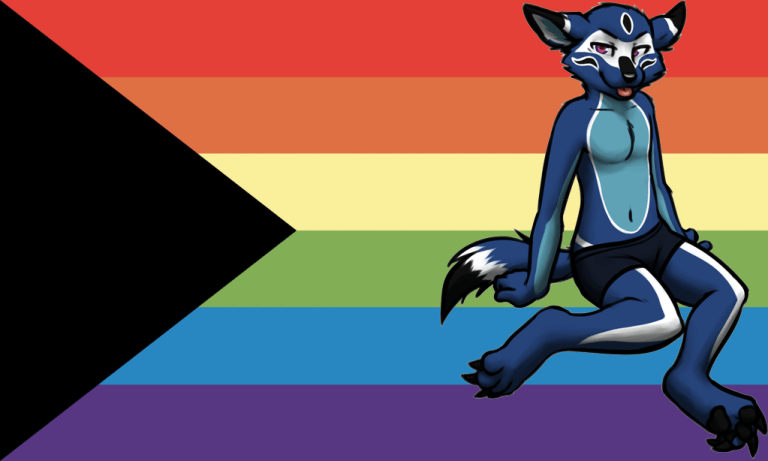
A lot of Americans like to think of themselves as “Free Speech” proponents. Some of them get all sweaty over whether or not they should be allowed to broadcast, and profit from, bigoted or hateful content laden with slurs.
And yet, the most censored people in American society are, without a doubt, sex workers. And you rarely hear any so-called “Free Speech” proponents give an iota of shit about the plight of sex workers. They can’t even freely engage in commerce here.
Sex work is explicitly banned by most financial service providers, such as PayPal. It’s exceedingly difficult for sex workers to make ends meet without constantly having to worry about their accounts being frozen and funds inaccessible.
There are a lot of reasons why the plight of sex workers is so bad in America. At the top of the list is the intersection of conservative politics and evangelical Christianity, which overall condemns healthy and consensual expressions of human sexuality. (Ever noticed how the only people who think they have a “sex addiction” are religious or right-wing? Not a coincidence.)
Do you know who else is a target of evangelicals and conservatives?
Furries, as you might know, are widely considered an LGBTQIA+ subculture (although not all of us are LGBTQIA+; only about 80%). But we’re more than just an LGBTQIA+ subculture. We’re also a vibrant community filled with skilled artists. Some of this art is pornographic in nature. It turns out, when queer people aren’t forced into the closet, they tend to embrace shameless authenticity and celebrate their romantic and sexual attractions with pride.
https://twitter.com/Pinboard/status/992819169593716737
A few years ago, the Death Eaters in Congress passed two bills (FOSTA and SESTA) that were advertised as an attempt to crack down on “sex trafficking”.
In practice, these laws killed Pounced.org–the only furry “dating” site at the time that wasn’t a sketchy cash grab (FurryMate, FurFling, etc.). Pounced.org died because the cost to avoid being criminally prosecuted under these laws was so exorbitant that they couldn’t sustain the website anymore, and it probably wasn’t the only small dating site to be killed by poor legislation. Only the big players could really have front-loaded these costs.
Which leads to the meat of this issue…
Why Furries Might Be Interested in Cryptocurrency
Cryptocurrency can be very attractive to members of the furry fandom because of the bullshit baked into the societies and cultures we exist in.
Cryptocurrency promises to be permissionless and decentralized; to bank the unbanked. If you make your living filling up someone else’s spank bank, the idea of creepy rich white men not being able to exercise targeted censorship against you or your family is, frankly, irresistible.
“Can’t use PayPal for your trade? Just setup a cryptocurrency wallet and give a different address to each of your clients, and instructions on how to access some vaguely reputable cryptocurrency exchange.”
Granted, most furries aren’t sex workers or porn artists, but some of our friends are, and we want to see them protected. But there’s another threat that cryptocurrency promises to alleviate: Chargeback fraud.

(Art by Khia)
This is the usual story (although exceptions do exist) I heard from my artist friends:
Someone under 18 decides they want to commission an artist they cannot personally afford, so they steal their parent’s credit card and use it to pay for a commission. Later–often after the work has been completed and delivered to the client–their parent notices the unauthorized charge on their credit card, and issues a chargeback.
Not only does this steal from the artist, but it incurs a $35 fee and increases the risk of their account being permanently suspended by their payment provider–thereby preventing them from accessing the funds paid to them by legitimate customers.
“Thanks for the free art! Now you’re at least $35 poorer and maybe lost your only lifeline out of perpetual poverty.”— Assholes
And thus, the Siren Song repeats once again!
Cryptocurrency doesn’t prevent chargeback fraud, but it does shift the risk from independent artists that have no capital or political power and onto billion dollar financial institutions like Coinbase.
Once the cryptocurrency has been transferred from the Coinbase wallet to the furry artist, it cannot be unspent. Bad faith behavior might still happen, but the artist doesn’t risk their livelihood because of it.
And that’s why, when furry auction site The Dealer’s Den announced a plan to rebuild with “Blockchain Technology”, I didn’t even bat an eye. It seems like an obvious solution to a pervasive unsolved problem to me.
Sure, it’d be great if we could solve this problem with sensible civil policy. But when is that going to finally happen? After all, we’re talking about the same governments that bungled COVID-19 last year, and the AIDS crisis last century, and so on…
https://www.youtube.com/watch?v=aJtvKSUPICA
However, and this bears emphasizing, the CryptoArt / NFT trend is not a valid reason to get involved in cryptocurency! As I said on Twitter:
https://twitter.com/SoatokDhole/status/1370045499122843654
https://twitter.com/SoatokDhole/status/1370046285798064128
https://twitter.com/SoatokDhole/status/1370047071949033472
https://twitter.com/SoatokDhole/status/1370047509314297862
So, super long preamble aside, what I thought I’d do today is talk a bit about cryptocurrency and how to engage with the topic responsibly, especially if you’re trying to mitigate the damage of the systems we inherited.
Cryptocurrency For Furries
I’m going to be very light on technical jargon, in the interests of accessibility, but at the risk of being imprecise.
No two cryptocurrencies are created equal. If you’re hoping to use one to mitigate systemic harms to our community, I implore you to learn the technical details in depth.
Decentralized Consensus
Cryptocurrencies can be classified by something called their consensus mechanism, which is how they can maintain a consistent ledger without being centralized. It doesn’t really matter, for the purpose of this article, how any of them work. I’m happy to dive into that in a future blog post, should anyone want it.
What you need to know is that Proof-of-Work (PoW) consensus algorithms are designed to maximize energy waste across the entire cryptocurrency network. That’s how it maintains its security against different kinds of esoteric-sounding attacks.
When you “mine” a Proof-of-Work cryptocurrency, what you’re doing is solving a computationally hard puzzle (e.g. find a number that, when combined with the previous block’s hash and your address and hashed, produces a specific number of leading 0 bits determined by an algorithm to ensure this happens at a set average frequency of time), which results in the entire network agreeing that your address gets the “block reward” (a fixed amount of whatever currency) plus transaction fees.
Cryptocurrency discussions frequently invite conversations about the environmental impact of mining. Proof-of-Work is the cause for this excess energy use which certainly contributes to global climate change.
So, if you’re going to get involved with cryptocurrency without contributing to global climate disaster, you’re going to want to avoid Proof-of-Work cryptocurrencies. There are several other options to choose from.
Proof-of-Stake is popular among my cryptocurrency nerd friends, although it receives a fair bit of criticism from experts (especially the “nothing at stake” problem). Ask your cryptographer. It’s probably not me.
On-Chain Privacy
The vaunted “blockchain” is a public, transparent record of all transactions.
When you use a cryptocurrency like Bitcoin, it’s sort of like tweeting your financial activities for the world to see.
“But nobody knows who owns this address,” Bitcoin maximalists might argue. To which I point out: Nobody is supposed to know your sockpuppet Twitter accounts either, but when you use them to harass someone right after they block your main account, we know it’s you.

(Art by Khia)
Some cryptocurrencies, like Zcash, try to provide something like TLS for your transactions. When you use shielded Zcash addresses, the transaction amounts and recipients are encrypted, and this ciphertext is accompanied by a zero-knowledge proof to ensure the total amount in the shielded and unshielded pools remains consistent.
I highly implore you to choose a cryptocurrency that has on-chain privacy, especially if your target audience includes queer people and/or sex workers.
Mainstream Appeal
Finding a privacy-preserving cryptocurrency that doesn’t equate to Global Warming Bucks is a tall order, but if you want people to actually use a cryptocurrency, it needs to be accessible.
By accessible, I mean available on all the mainstream cryptocurrency exchange platforms (Coinbase, Binance, Bitfinex, etc.).
This might sound like pointless gatekeeping, but remember: They have the money and lawyers to negotiate with the economic powerhouses of the world, while sex workers and furry artists do not.
Cryptographic Security
Any regular reader of Dhole Moments probably saw this section coming a mile away, but an important consideration for a cryptocurrency to build upon is whether or not it’s actually secure.
This is where things get tricky. Weird or poor choices in cryptographic algorithm don’t seem to matter much.
Bitcoin uses ECDSA over Koblitz curves. IOTA shipped two broken hash functions, threatened researchers, and then tried to claim the first broken hash function was backdoored for “copy protection”. The CryptoNote currencies (n.b. Monero) tried to build on EdDSA but introduced a double spend attack.
I’m certainly not qualified to audit an entire cryptocurrency and say “yes/no” on its security. But any cryptocurrency you consider should at least pass a smoke test from your cryptographer.
Which Cryptocurrency Should I Choose?
If you’re looking for a cryptocurrency that’s secure, accessible, privacy-preserving, and doesn’t waste a fuck ton of energy all the time, the short answer is that there is none. You’re going to have to make a trade-off.

(Art by Khia)
I’m sure there are cryptocurrency projects that use privacy-preserving technologies without a Proof-of-Work algorithm, and their design and implementation might even be secure! But, to date, I’m not aware of any such projects that also have mainstream accessibility on large exchange platforms.
You’ll notice that I didn’t mention price volatility in my list above. There’s two reasons for that:
- I’m not a financial expert. For all I know, price volatility might be something you want out of your cryptocurrency, especially if you’re LARPing a day trader.
- It’s hard enough to make this choice without adding more complications to the formula.
If Zcash ever adopted a consensus algorithm that wasn’t Proof-of-Work, it’d be a shoe-in for me to recommend. It checks all the other boxes neatly and is one of the most interesting cryptography projects on the Internet, after all.
In the meantime, maybe some other project will fill this niche and become widely accessible for everyone. There’s a lot of exciting and/or scary things happening with cryptocurrency research.
If you’re stuck with a hard decision, honestly, just do the best you can and be very transparent about the trade-offs you’re making and why you’re making them. Then ask a friend or expert to check your reasoning before you commit to it. “Do nothing” also needs to be publicly considered, no matter how absurd it might seem.
Disclaimers and Other Remarks
I do not work with cryptocurrency in my dayjob. I’d like to say that, consequently, I don’t have a conflict of interest, but all humans have subconscious biases, and a lot of my favorite people in cryptography do work in or with cryptocurrency. I want my friends to be able to continue to do awesome work without feeling ashamed.
https://twitter.com/cryptolexicon/status/1331712883403722752
Thus, I don’t care if you invest in Bitcoin or Dogecoin or whatever. Shoot for the moon while you awoo at the moon. Just be careful; for every winner, there’s at least one loser.

(Art by Khia)
I’m a fan of transparency logs–which are often compared to blockchains, but without the currency aspect. If you’re not familiar, read up on Trillian and Chronicle. Notably, Trillian is the backbone of Certificate Transparency, which helps keep the CA infrastructure honest and consequently makes HTTPS safer for everyone.
https://soatok.blog/2021/04/19/a-furrys-guide-to-cryptocurrency/
#Cryptocurrency #furries #furry #furryArtists #FurryFandom #Politics #Society
If you’ve somehow never encountered an Internet meme before, you may be surprised to learn that the number 69 is often associated with sex (and, more specifically, a particular sex act).This happens to be the 69th blog post published on Dhole Moments, since I started the blog in April 2020.
You could even go as far as to say it’s the 4/20 +69th post, for maximum meme potential.
42069, get it? (Art by Khia)
However! I make a concerted effort to keep my blog safe-for-work, so if you’re worried about this post being flooded with furry porn (a.k.a. yiff art), or cropped yiff memes, or any other such lascivious nonsense, you won’t find any of that on this blog. (Sorry to disappoint.)
Instead, I’d like to take the opportunity to correct some public misconceptions about human sexuality, identity, and how these topics relate to the furry fandom.
Is Furry a Sex Thing?
I find it difficult to overstate how often people assume the “furry is a sex thing” premise. Especially on technical forums.But let’s backtrack for a second. What isn’t a sex thing?
Art by Khia.
This turns out to be a difficult question to answer. Even Wikipedia’s somewhat concise list of paraphilias doesn’t leave a lot of topics off the table.
Are shoes a sex thing? Are cigarettes? Poetry?
Comic from Saturday Morning Breakfast Cereal.
Hell, one might be tempted to cry foul on the header image used in this blog post for including tentacles, hypnotic eyes, and footpaws in the same image. (Scandalous!) But if you look at the uncropped versions of these images, you’ll quickly realize they aren’t yiffy.
Top Art by AtlasInu.
Bottom: Created by FlashWhite_. Fox is Kiit Lock.
The more you read about this topic, the more you’ll realize this question is inert. Anything can be a sex thing. Humans are largely a sexual species, and sex is deeply ingrained in our culture (which can make life awkward for asexual people).Instead, the question of whether or not the furry fandom is sexual becomes a bit of a Rorschach test for one’s cognitive biases.
If you’re chiefly concerned with public image–especially when fursuiting in public, where kids can see–you’re incentivized to double down on the fact that the furry fandom is no more inherently sexual than anything else can be. And this is true.
If you’re concerned with cultivating a sex-positive environment where people can live out their sexual fantasies in a safe, sane, and consensual manner, you’re incentivized to insist that furry is a sexual thing. “We have murrsuits for crying out loud! Stop kink-shaming! Down with puritan ideologies on sex!” And this is also true.
Humans are largely sexual, so any activity humans engage in will inevitably involve people sexualizing it. Even tupperware parties, for fuck’s sake! Anyone who believes there is a “Rule 34 of the Internet” tacitly acknowledges this fact, even if it’s inconvenient for a narrative they’re trying to spin.
So while this might be a meaningless question, one has to wonder…
Why Does Everyone Care So Much If Being a Furry (In Particular) Is Sexual or Not?
To understand what’s really happening here, you need to know a few things about the furry fandom.
- Approximately 80% of furries are LGBTQIA+ (source).
- Early anti-furry sentiments were motivated by queerphobia, especially on forums like Something Awful–and the influence of early hateful memes can still be seen to this day.
https://twitter.com/spacetwinks/status/728349066178998274
One of the Something Awful staff eventually acknowledged and apologized for this.
Archived from here. To corroborate, an Internet author named Maddox once parodied SomethingAwful’s hateful obsession with furries.
There was even a movement within the furry fandom history (the “Burned Furs“) that aimed to excise queerness and sex-positivity from the community. It’s no coincidence that a lot of the former Burned Furs joined with the alt-right movement within the furry fandom.
The alt-right is explicitly queerphobic; especially against trans people. But it’s not just queerphobic; it’s also an ableist and racist movement.
Regardless of sexual orientation, a lot of furries are neurodivergent, too.
Simply put: The reason that most people care whether or not furries are sexual is rooted in the propensity of anti-furry rhetoric in Internet culture, which was motivated at its inception by mostly queerphobia with a dash of ableism.
Art by Khia.
The notion that furries are “too sexual” originated as a dog-whistle for “too gay”, and caught on with people who didn’t know the hidden meaning of the idea. Now a lot of people repeat these ideas without intending or even knowing their roots, and many more have internalized shame about the whole situation.
Unfortunately, this even precipitates into the furry fandom itself, which leads to an unfortunate cyclical discourse that takes place largely on Furry Twitter.
Original tweet unavailable
Furry Isn’t a Sexuality. There is no F in LGBT!
If you publicly state “anti-furry rhetoric is largely queerphobic dog-whistles”, you will inevitably hear someone try to retort this way. So let’s be very clear about it.Furry isn’t its own sexual identity, and I would never claim otherwise.
Unlike transgender people, furries do not experience anything like “species dysphoria” (although therians/otherkin do report experiencing this; don’t conflate the two).
What’s happening here is: Most furries (about 80% of us) have separate sexual/gender identities that deviate from the heteronormative. A lot of queerphobia is easier to sell when you convey it through dog-whistles. So that’s what bigots did.
Polite company that wouldn’t partake in queer-bashing is often willing to laugh at the notion of “Beat A Furry Day“.
Anyone who tries to twist this acknowledgement to mean something ridiculous like an LGBTF movement is either being irrational or a 4chan troll.
Art by Khia.
For related reasons, you shouldn’t ever feel the need to “come out” as a furry.
https://www.youtube.com/watch?v=ZG2DRLimBSM
It’s okay to just really like Beastars, Zootopia, or even the Furry aspects of the Minecraft and Roblox communities. It doesn’t make you a sex-freak.
What’s the Take-Away?
It doesn’t really matter if the furry fandom has a sexual side to it. Everything does! The people who proclaim to care very much about this care for all the wrong reasons. Don’t be one of them.
Art by Swizz.
And remember: Lewd furries aren’t furry trash; we’re yiff-raff!
Sex Isn’t Well-Defined Either
While we’re talking about sex, did you know that biological sex isn’t neatly divided into “male” and “female”? This isn’t an ideological position; it’s a scientific one. Just ask a biologist!https://twitter.com/JUNIUS_64/status/1054387892624285699
Trans and nonbinary people change gender (which is about your role within society) from what they were assigned at birth, but even sex itself isn’t so concrete.
The next time someone tries to appeal to “science” when talking about trans rights and then vomits up some unenlightened K-12 explanation of human reproduction and biological sex, remind them that science disagrees with their oversimplified and outdated mental model–and they might know this if they kept up with scientists.
Where Can I Learn More About the Sexual Side of the Furry Fandom?
Important: If you’re under the age of 18, you should stay out of adult spaces until you’re old enough to participate. No excuses.If you’re looking for pornographic furry art (also called “yiff”), most furry art sites (FurryLife, FurAffinity, etc.) have adult content filters that you can turn off when you register an account.
If you’re looking for something more interactive, there’s a swath of furries that develop private VR experiences for 18+ audiences. One of the most well-funded Patreon artists makes adult furry games.
If you’re curious about why and how people express their sexuality when fursuiting (also called “murrsuiting”), there’s a subreddit for that.
It’s really not hard to find. This is one of the advantages of furry being a largely sex-positive community.
Furry YouTuber Ragehound even has a series about Furries After Dark if you want to learn more about these topics.
https://www.youtube.com/watch?v=nGOlQJDO5no
Finally, similar to how 69 is a meme number for sex, furries have an additional meme number (621) that comes from the name of an adult furry website (e621.net).
You now have enough knowledge to navigate the adult side of the fandom. Just don’t come crying to me when you develop the uncanny knack for recognizing which r/furry_irl posts are actually cropped yiff versus wholly worksafe art.
https://soatok.blog/2021/04/02/the-furry-sexuality-blog-post/
#furries #furry #FurryFandom #LGBTQIA_ #Society



